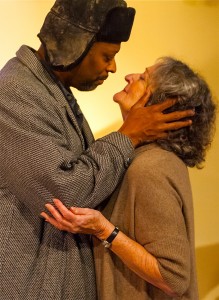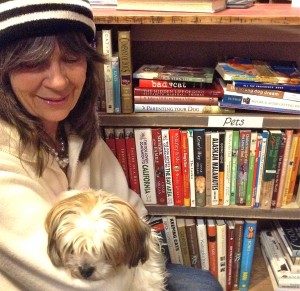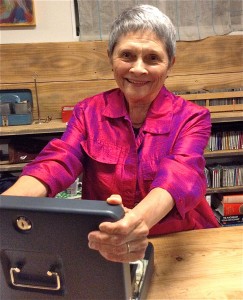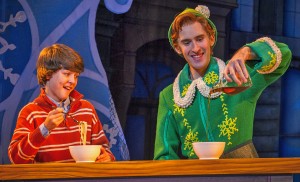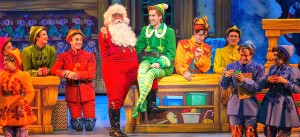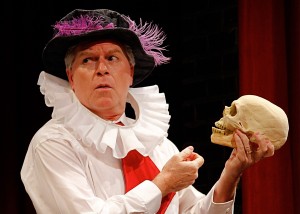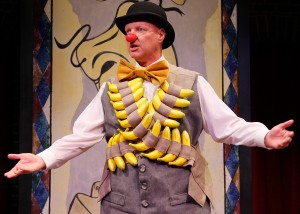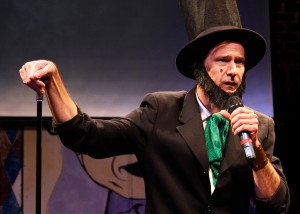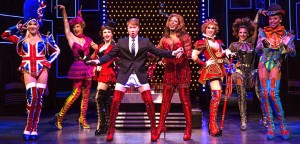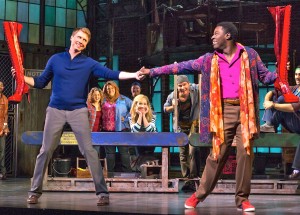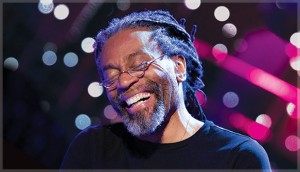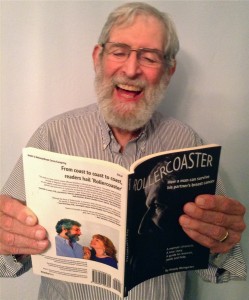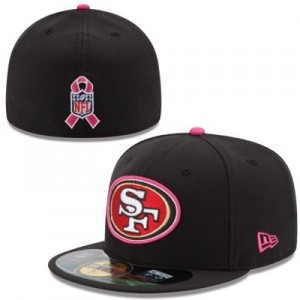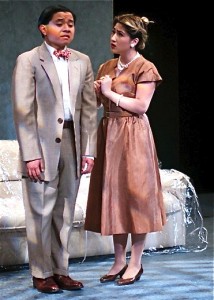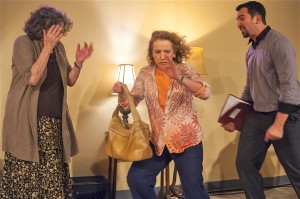
In “Landless,” an angry Josiah (Nick Garcia) chases Natalie (Emilie Talbot) from shop owned by Elise (Patricia Silver). Photo by David Allen.
[Woody’s [rating: 2.5]
Two long rows of seats bordering the latest AlterTheater stage were so tightly packed it could have been a disaster had anyone needed a bathroom break mid-show.
A single theatergoer’s bad breath, in fact, might have been nearly as bad.
But, thankfully, nothing disrupted the world premiere of “Landless” in a storefront next to Johnny Doughnuts on west 4th Street in San Rafael.
That was a good thing because I, like everyone else opening night, needed all my faculties to absorb the breadth of issues — and myriad flashbacks — proffered by playwright Larisse FastHorse in a mere two hours.
Enough, actually, to swamp my mind:
Native American heritage, homelessness, racism, bullying, discount stores choking ma-and-pa shops, the proliferation of casinos, and — in case that’s insufficient — friendship, love and benevolence.
It was as if she wanted to probe in two acts every feeling she’d had in her 43 years.
Her thematic pileup parallels the set, a mélange of cartons and racks of outdated and broken dreams from the life of Elise, a worn out and tapped out 68-year-old whose fingers are wedged in a metaphoric post-recession dike at her Matthews Mercantile store.
Not everything in “Landless” is hyper-serious, though.
Or depressing.
FastHorse sporadically uses humor as a leaven.
The play takes place in a small town where a new Walmart is squeezing fourth-generation Main Street merchants. But to find the heart of “Landless,” FastHorse, a member of the Sicangu Lakota Nation originally from South Dakota, interviewed local Indian elders, shopkeepers and business district residents.
Plus the homeless.
Silver makes the drama’s heart pound rapidly by passionately running a proverbial gamut of emotions as Elise.
And Nick Garcia is alternatively childlike, joyous, unhappy and angry as Josiah. a Hispanic-surnamed boy/man Elise had rescued 17 years before, a gay dreamer who’s part of a “landless tribe” seeking federal recognition.
He repeatedly tests the topic of identity.
“Do you know what it’s like to know who you are?” he ponders.
Emile Talbot and Michael J. Asberry fill out the cast by proficiently assuming several supporting roles each.
Mood-heightening lighting by Jack Beuttler also is noteworthy, especially since the storefront windows are left undraped so passersby can sneak a peek.
Bay Area theatrical legend Ann Brebner is an ex-casting director who led the drive to restore the Rafael Theatre and co-founded the Marin Shakespeare Company. Jeanette Harrison co-founded the nomadic AlterTheater in 2004, when the troupe turned a rocking chair store into a performance space.
Jointly, they directed “Landless.”
The two worked extremely well together, Harrison told me, but some rehearsal differences led them to test opposite ways of doing some scenes and then choose.
Opening night jitters, I suspect, can be blamed for multitude lines spurting forth before their cues were uttered.
That problem will undoubtedly get ironed out quickly.
But other flaws are not so easily corrected.
The faint recorded musical backdrop, for example, seems more intrusive than illuminating.
And I found some clichés irritating. Such as “You are not alone.” Or, “I need you to walk out this door and never look back.”
From play to play, the AlterTheater moves from storefront to storefront in downtown San Rafael, priding itself on prompting artists to “dream big, take risks, and push themselves to the limits of their imagination…and then take another step.”
I believe by exploring Indian culture and heritage, certainly not a mainstay of the Bay Area theatrical scene, it again has met that objective.
Now, if it would focus on a couple of the planet’s ills and not try to solve all of them at once…
“Landless” will play at the AlterTheater’s temporary space at 1619 4th St. (at G), San Rafael, through Feb. 1, then at the A.C.T. Costume Shop Theater, 1117 Market St. (at 7th), San Francisco, Feb. 12-22. Evening performances in San Rafael, Fridays and Saturdays at 8 p.m., Sundays at 7 p.m.; matinees, Sundays at 2:30 p.m. Tickets: $25. Information: (415) 454-2787 or www.altertheater.org.
Check out Woody Weingarten’s www.vitalitypress.com blog, or contact him at voodee@sbcglobal.net.


